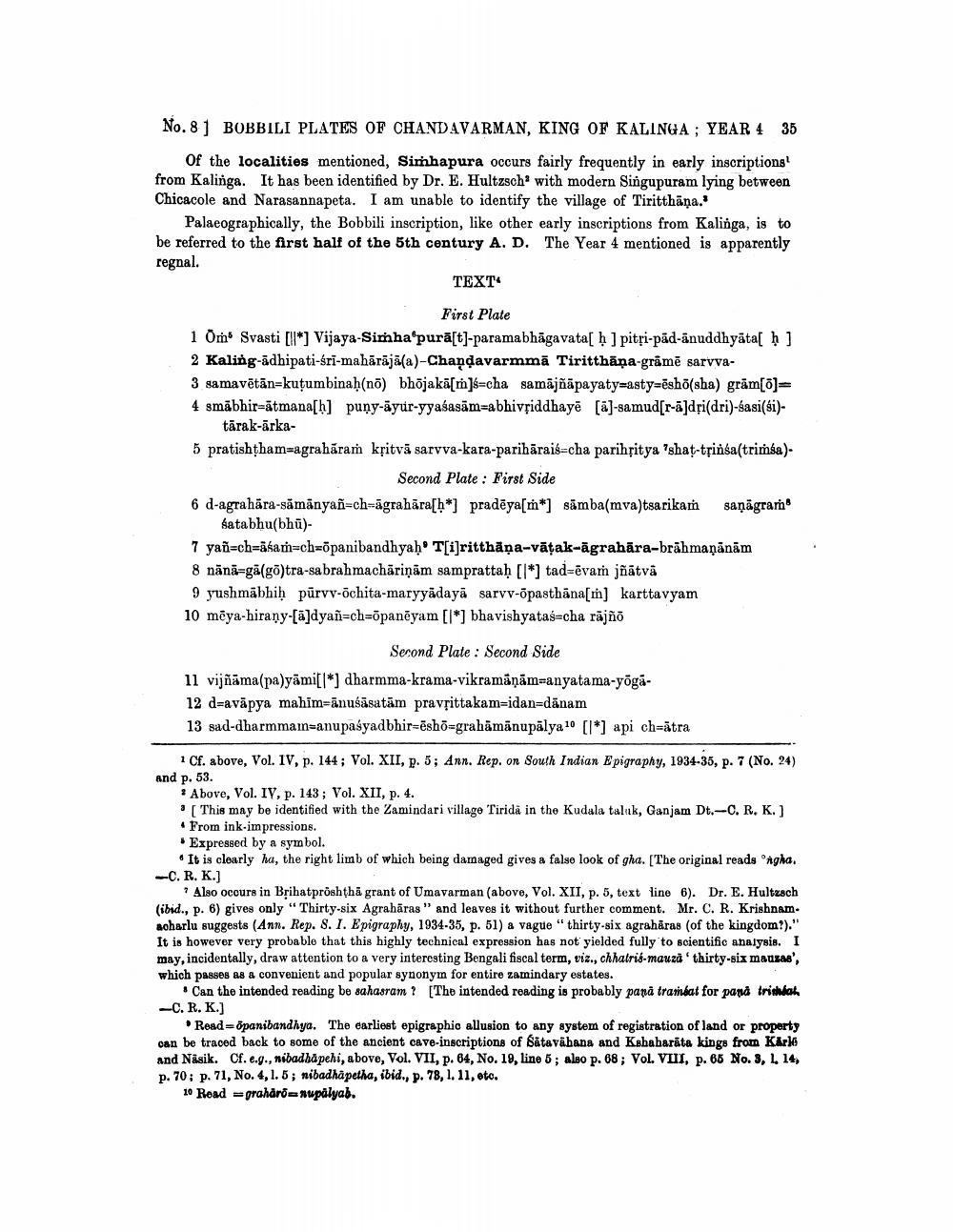________________
No. 8
BOBBILI PLATES OF CHANDAVARMAN, KING OF KALINGA; YEAR 4 35
Of the localities mentioned, Simhapura occurs fairly frequently in early inscriptions' from Kalinga. It has been identified by Dr. E. Hultzsch3 with modern Singupuram lying between Chicacole and Narasannapeta. I am unable to identify the village of Tiritthana."
Palaeographically, the Bobbili inscription, like other early inscriptions from Kalinga, is to be referred to the first half of the 5th century A. D. The Year 4 mentioned is apparently regnal.
TEXT
First Plate
1 Om Svasti [*] Vijaya-Simha'pura(t)-paramabhāgavata[b]pitzi-pâd-ânuddhyta[b]
2 Kaling-adhipati-śrī-mahārājā(a)-Chaṇḍavarmmā Tiritthāņa-grāmē sarvva
3 samavētān-kufumbinaḥ(nő) bhöjakk[th]-cha samäjääpayaty-asty-ishō(sha) gråm[8]➡
4 smabhir-atmana[b] pany-ayur-yyalasām-abhivriddhaye [4]-samud[r]dri(dri)-śasi(i)tārak-ārka
Satabha(bhū)
5 pratishtham-agraharam kritvā sarvva-kara-parihārais-cha parihçitya 'shat-triña(tria)Second Plate: First Side
6 d-agrahara-samanyañ-ch-agrahara[h*] pradēya[m*] samba(mva)tsarikam saṇāgram®
↑ yañ-ch-ah-ch-õpanibandhyaḥ* T[i]ritthāṇa-väṭak-ägrahāra-brāhmaṇānām
8 nāmā gā(g)tra-sabrahmachāriņām samprattaḥ [*] tad-ēvam jāvā
9 yushmabhi parvv-öchita-maryyadaya sarvv-öpasthana[th] karttavyam
10 meya-hirany-[a]diyañ=ch=ōpanēyam [|*] bhavishyatas-cha räjñā
Second Plate: Second Side
11 vijñāma(pa)yāmi[*] dharmma-krama-vikramaņām-anyatama-yōgā
12 d=avapya mahim-anusāsatām pravṛittakam-idan-dānam
13 sad-dharmmamanupasyadbhir-ishō-grahāmānupālya1o [*] api ch-tra
1 Cf. above, Vol. IV, p. 144; Vol. XII, p. 5; Ann. Rep. on South Indian Epigraphy, 1934-35, p. 7 (No. 24)
and p. 53.
Above, Vol. IV, p. 143; Vol. XII, p. 4.
[This may be identified with the Zamindari village Tirida in the Kudala taluk, Ganjam Dt.-C. R. K. ] From ink-impressions. Expressed by a symbol.
It is clearly ha, the right limb of which being damaged gives a false look of gha. [The original reads "ngha. -C. R. K.]
? Also occurs in Brihatprōshtha grant of Umavarman (above, Vol. XII, p. 5, text line 6). Dr. E. Hultzsch (ibid., p. 6) gives only "Thirty-six Agraharas" and leaves it without further comment. Mr. C. R. Krishnamacharlu suggests (Ann. Rep. S. I. Epigraphy, 1934-35, p. 51) a vague "thirty-six agraharas (of the kingdom?)." It is however very probable that this highly technical expression has not yielded fully to scientific analysis. I may, incidentally, draw attention to a very interesting Bengali fiscal term, viz., chhatris-mauza' thirty-six mauzas', which passes as a convenient and popular synonym for entire zamindary estates.
* Can the intended reading be sahasram? [The intended reading is probably pana trambat for pană trimbah -C. R. K.]
⚫ Read opanibandhya. The earliest epigraphic allusion to any system of registration of land or property can be traced back to some of the ancient cave-inscriptions of Satavahana and Kahabarata kings from Kārli and Näsik. Cf. e.g., nibadhapehi, above, Vol. VII, p. 64, No. 19, line 5; also p. 68; Vol. VIII, p. 65 No. 3, 1, 14, p. 70; p. 71, No. 4, 1.5; nibadhapetha, ibid., p. 78, 1. 11, etc. 10 Read-graharo➡nupalyab.




